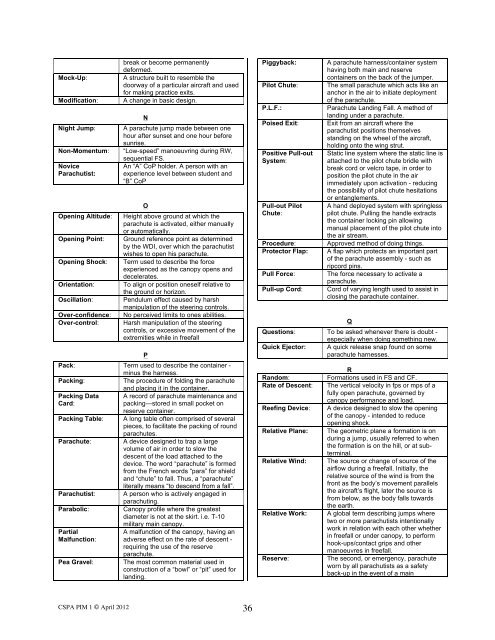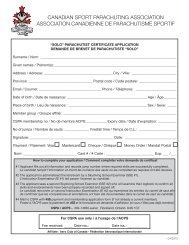PIM 1 2012 Final - Canadian Sport Parachuting Association
PIM 1 2012 Final - Canadian Sport Parachuting Association
PIM 1 2012 Final - Canadian Sport Parachuting Association
You also want an ePaper? Increase the reach of your titles
YUMPU automatically turns print PDFs into web optimized ePapers that Google loves.
eak or become permanently<br />
deformed.<br />
Mock-Up: A structure built to resemble the<br />
doorway of a particular aircraft and used<br />
for making practice exits.<br />
Modification: A change in basic design.<br />
N<br />
Night Jump: A parachute jump made between one<br />
hour after sunset and one hour before<br />
sunrise.<br />
Non-Momentum: “Low-speed” manoeuvring during RW,<br />
sequential FS.<br />
Novice<br />
Parachutist:<br />
An “A” CoP holder. A person with an<br />
experience level between student and<br />
“B” CoP<br />
O<br />
Opening Altitude: Height above ground at which the<br />
parachute is activated, either manually<br />
or automatically.<br />
Opening Point: Ground reference point as determined<br />
by the WDI, over which the parachutist<br />
wishes to open his parachute.<br />
Opening Shock: Term used to describe the force<br />
experienced as the canopy opens and<br />
decelerates.<br />
Orientation: To align or position oneself relative to<br />
the ground or horizon.<br />
Oscillation: Pendulum effect caused by harsh<br />
manipulation of the steering controls.<br />
Over-confidence: No perceived limits to ones abilities.<br />
Over-control: Harsh manipulation of the steering<br />
controls, or excessive movement of the<br />
extremities while in freefall<br />
P<br />
Pack: Term used to describe the container -<br />
minus the harness.<br />
Packing: The procedure of folding the parachute<br />
and placing it in the container.<br />
Packing Data<br />
Card:<br />
A record of parachute maintenance and<br />
packing—stored in small pocket on<br />
reserve container.<br />
Packing Table: A long table often comprised of several<br />
pieces, to facilitate the packing of round<br />
parachutes.<br />
Parachute: A device designed to trap a large<br />
volume of air in order to slow the<br />
descent of the load attached to the<br />
device. The word “parachute” is formed<br />
from the French words “para” for shield<br />
and “chute” to fall. Thus, a “parachute”<br />
literally means “to descend from a fall”.<br />
Parachutist: A person who is actively engaged in<br />
parachuting.<br />
Parabolic: Canopy profile where the greatest<br />
diameter is not at the skirt. i.e. T-10<br />
military main canopy.<br />
Partial<br />
Malfunction:<br />
A malfunction of the canopy, having an<br />
adverse effect on the rate of descent -<br />
requiring the use of the reserve<br />
parachute.<br />
Pea Gravel: The most common material used in<br />
construction of a “bowl” or “pit” used for<br />
landing.<br />
CSPA <strong>PIM</strong> 1 © April <strong>2012</strong> 36<br />
Piggyback: A parachute harness/container system<br />
having both main and reserve<br />
containers on the back of the jumper.<br />
Pilot Chute: The small parachute which acts like an<br />
anchor in the air to initiate deployment<br />
of the parachute.<br />
P.L.F.: Parachute Landing Fall. A method of<br />
landing under a parachute.<br />
Poised Exit: Exit from an aircraft where the<br />
parachutist positions themselves<br />
standing on the wheel of the aircraft,<br />
holding onto the wing strut.<br />
Positive Pull-out<br />
System:<br />
Pull-out Pilot<br />
Chute:<br />
Static line system where the static line is<br />
attached to the pilot chute bridle with<br />
break cord or velcro tape, in order to<br />
position the pilot chute in the air<br />
immediately upon activation - reducing<br />
the possibility of pilot chute hesitations<br />
or entanglements.<br />
A hand deployed system with springless<br />
pilot chute. Pulling the handle extracts<br />
the container locking pin allowing<br />
manual placement of the pilot chute into<br />
the air stream.<br />
Procedure: Approved method of doing things.<br />
Protector Flap: A flap which protects an important part<br />
of the parachute assembly - such as<br />
ripcord pins.<br />
Pull Force: The force necessary to activate a<br />
parachute.<br />
Pull-up Cord: Cord of varying length used to assist in<br />
closing the parachute container.<br />
Q<br />
Questions: To be asked whenever there is doubt -<br />
especially when doing something new.<br />
Quick Ejector: A quick release snap found on some<br />
parachute harnesses.<br />
R<br />
Random: Formations used in FS and CF.<br />
Rate of Descent: The vertical velocity in fps or mps of a<br />
fully open parachute, governed by<br />
canopy performance and load.<br />
Reefing Device: A device designed to slow the opening<br />
of the canopy - intended to reduce<br />
opening shock.<br />
Relative Plane: The geometric plane a formation is on<br />
during a jump, usually referred to when<br />
the formation is on the hill, or at subterminal.<br />
Relative Wind: The source or change of source of the<br />
airflow during a freefall. Initially, the<br />
relative source of the wind is from the<br />
front as the body’s movement parallels<br />
the aircraft’s flight, later the source is<br />
from below, as the body falls towards<br />
the earth.<br />
Relative Work: A global term describing jumps where<br />
two or more parachutists intentionally<br />
work in relation with each other whether<br />
in freefall or under canopy, to perform<br />
hook-ups/contact grips and other<br />
manoeuvres in freefall.<br />
Reserve: The second, or emergency, parachute<br />
worn by all parachutists as a safety<br />
back-up in the event of a main




